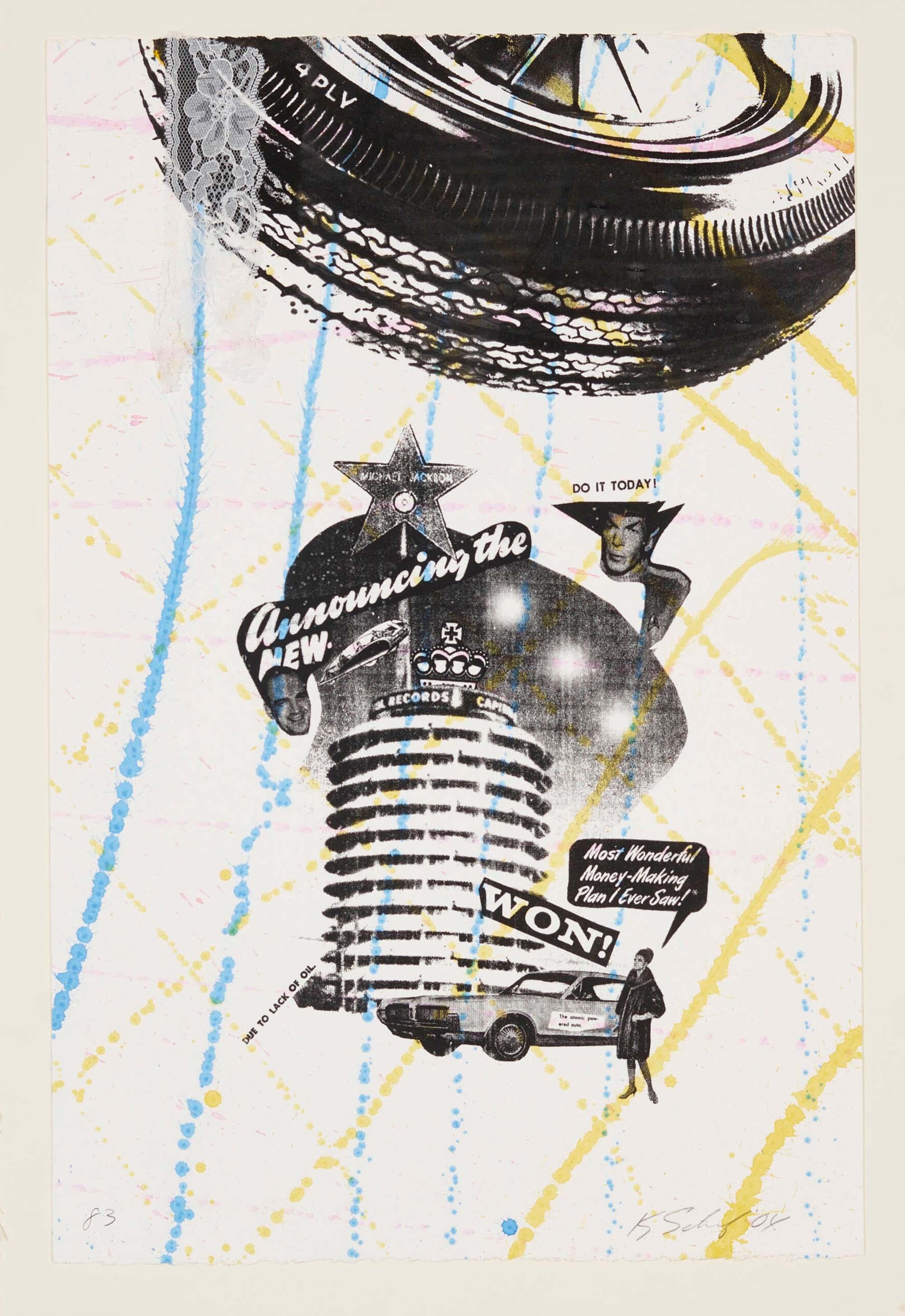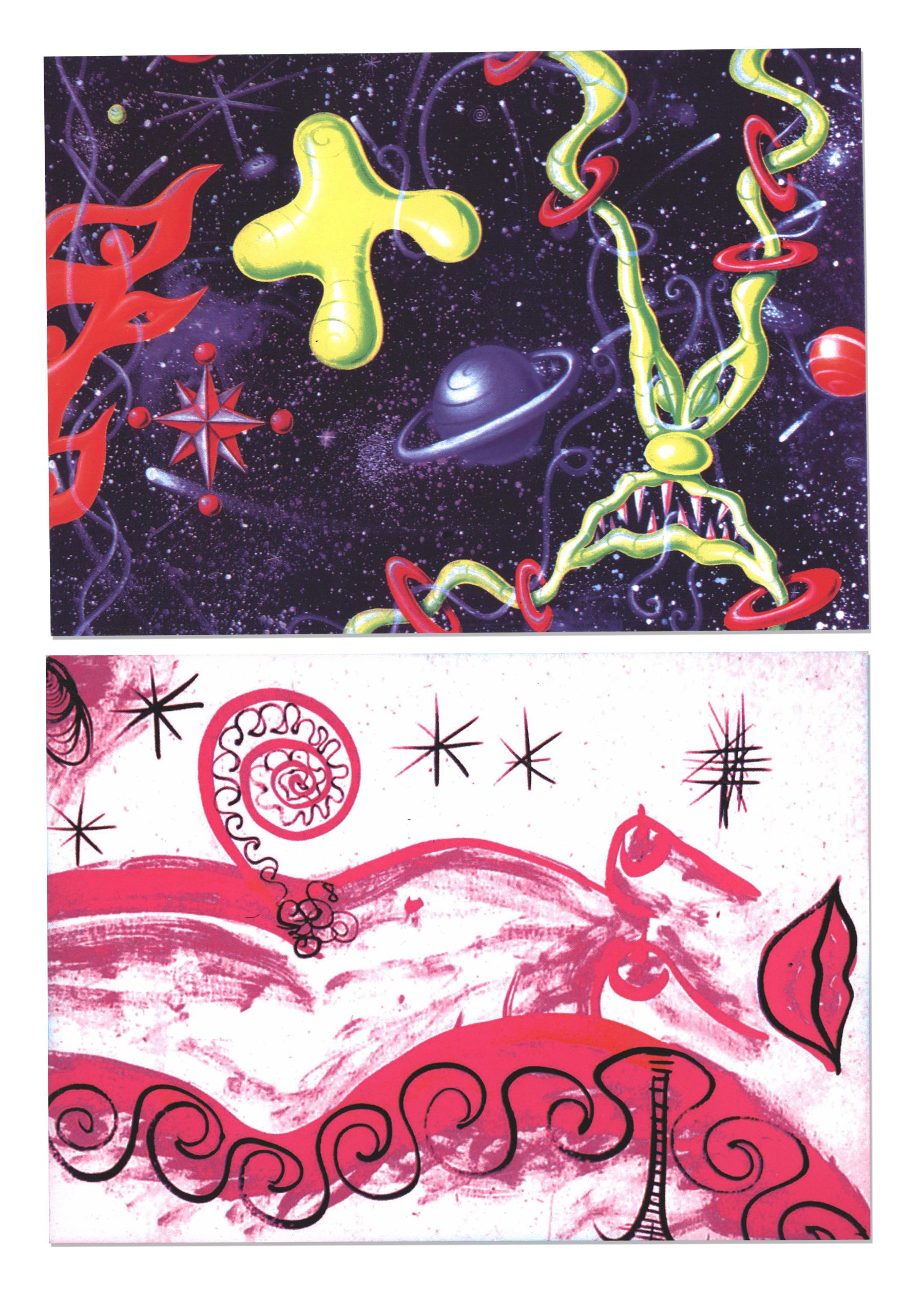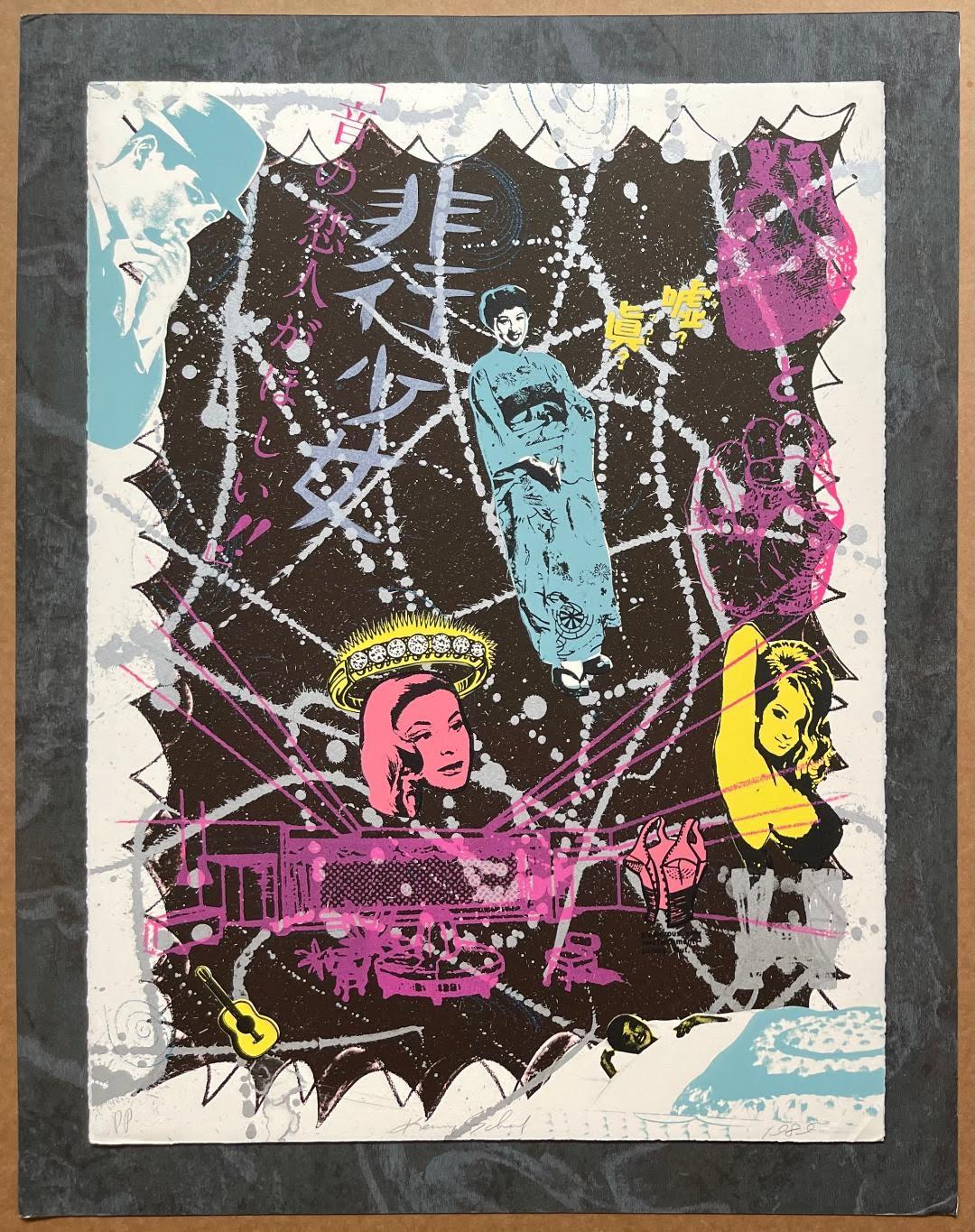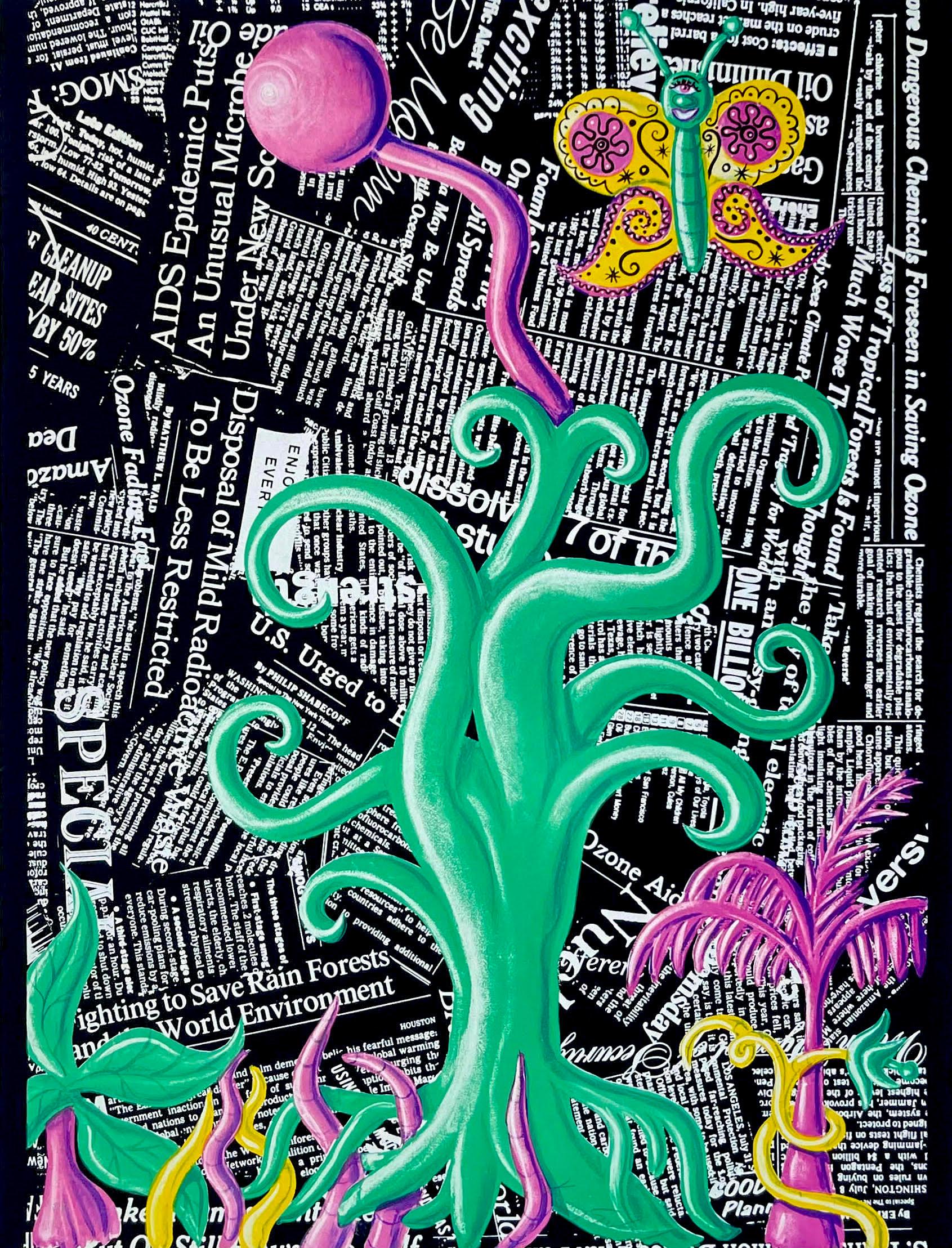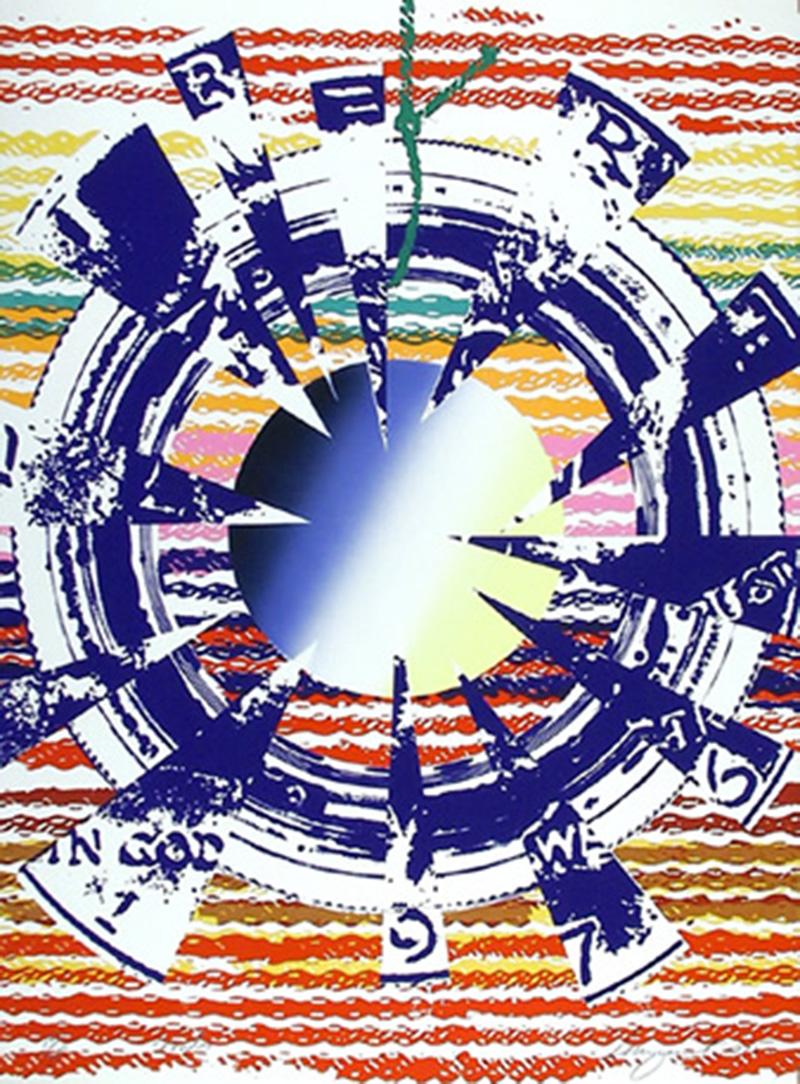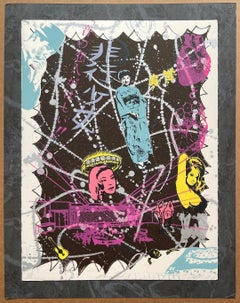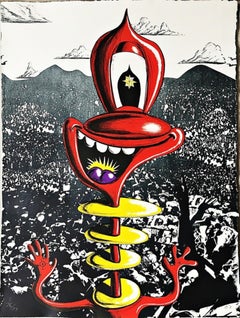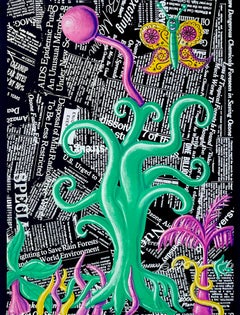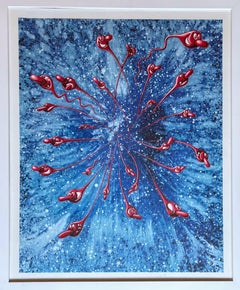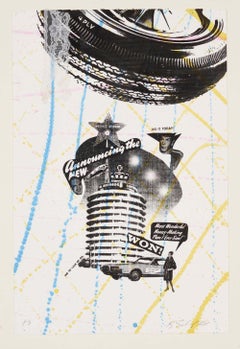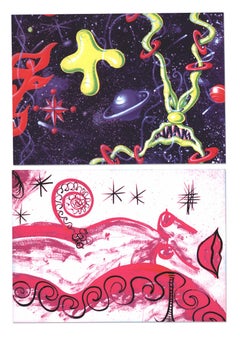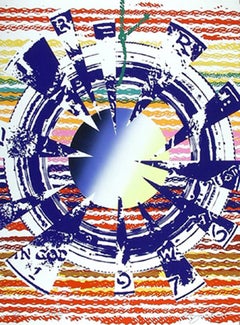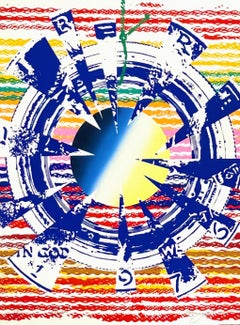Items Similar to Fun Vacation (200 Engberg) Lithograph signed 13/16 by Ed Ruscha AND Kenny Scharf
Want more images or videos?
Request additional images or videos from the seller
1 of 8
Ed Ruscha and Kenny ScharfFun Vacation (200 Engberg) Lithograph signed 13/16 by Ed Ruscha AND Kenny Scharf1990
1990
$14,000
$20,00030% Off
£10,867.35
£15,524.7930% Off
€12,327.01
€17,610.0130% Off
CA$19,989.76
CA$28,556.8030% Off
A$22,027.11
A$31,467.3130% Off
CHF 11,425.10
CHF 16,321.5730% Off
MX$261,982.88
MX$374,261.2630% Off
NOK 144,524.24
NOK 206,463.2030% Off
SEK 135,388.57
SEK 193,412.2430% Off
DKK 92,064.25
DKK 131,520.3530% Off
About the Item
Ed Ruscha and Kenny Scharf
Fun Vacation (200, Engberg), 1990
Lithograph in five colors on white Rives BFK paper (hand signed by BOTH Ed Ruscha and Kenny Scharf)
36 × 27 inches
Hand-signed by artist, Hand signed by both Ed Ruscha and Kenny Scharf lower right; dated lower right; hand numbered 13/16 in pencil; with the printer's blind stamp
Printed/Published by Hamilton Press
Catalogue Raisonné: 200, Engberg
Unframed
Rarely seen on the market, since most other editions are already in the permanent collection of major museums and institutions, "Fun Vacation (The Cruiser)" is the result of a unique collaboration three decades ago - 1990 - between Ed Ruscha and Kenny Scharf. This historic piece is hand signed by both Ruscha and Scharf and numbered from the very limited edition of only 16. A terrific piece for collectors and fans of both of these artists. The sheet has desirable deckled edges, excellent condition, with natural bleed-through colors, and therefore must ship flat and not rolled. The ship is a motif that Ed Ruscha has visited many times, particularly as it is pictured here as a shadowy mirage that seems to both emerge from and disappear into the fog. Ruscha’s work from this period is viewed by many as a metaphor for the end of the American Dream that was originated by valiant sailors as they sailed through uncertainty and found a new land. In a recent conversation at the Metropolitan Museum of Art, Ruscha acknowledged that his entire career has been preoccupied with this endlessly fascinating theme. And this work -depicting an almost unmoored ship, also alluding to American space exploration - is as emblematic as any of that theme. In this rare work, Ruscha and Scharf design a fantastical narrative around the recurrent motif of the ship. Here, the printed slogans and psychedelic color strips are emblematic of Ruscha and Scharf’s vibrant and satirist practice.
Ed Ruscha - Biography:
There are things that I’m constantly looking at that I feel should be elevated to greater status, almost to philosophical status or to a religious status. That’s why taking things out of context is a useful tool to an artist. It’s the concept of taking something that’s not subject matter and making it subject matter.
—Ed Ruscha
At the start of his artistic career, Ed Ruscha called himself an “abstract artist ... who deals with subject matter.” Abandoning academic connotations that came to be associated with Abstract Expressionism, he looked instead to tropes of advertising and brought words—as form, symbol, and material—to the forefront of painting. Working in diverse media with humor and wit, he oscillates between sign and substance, locating the sublime in landscapes both natural and artificial.
In 1956, Ruscha moved from Oklahoma City to Los Angeles, where he attended the Chouinard Art Institute. During his time in art school, he had been painting in the manner of Franz Kline and Willem de Kooning, and came across a reproduction of Jasper Johns’s Target with Four Faces (1955). Struck by Johns’s use of readymade images as supports for abstraction, Ruscha began to consider how he could employ graphics in order to expose painting’s dual identity as both object and illusion. For his first word painting, E.Ruscha (1959), he intentionally miscalculated the space it would take to write his first initial and surname on the canvas, inserting the last two letters, HA, above and indicating the “error” with an arrow. After graduation, Ruscha began to work for ad agencies, honing his skills in schematic design and considering questions of scale, abstraction, and viewpoint, which became integral to his painting and photography. He produced his first artist’s book, Twentysix Gasoline Stations—a series of deadpan photographs the artist took while driving on Route 66 from Los Angeles to Oklahoma City—in 1963. Ruscha since has gone on to create over a dozen artists’ books, including the 25-foot-long, accordion-folded Every Building on the Sunset Strip (1966) and his version of Kerouac's iconic On the Road (2009). Ruscha also paints trompe-l’oeil bound volumes and alters book spines and interiors with painted words: books in all forms pervade his investigations of language and the distribution of art and information.
Ruscha’s paintings of the 1960s explore the noise and the fluidity of language. With works such as OOF (1962–63)—which presents the exclamation in yellow block letters on a blue ground—it is nearly impossible to look at the painting without verbalizing the visual. Since his first exhibition with Gagosian in 1993, Ruscha has had twenty-one solo exhibitions with the gallery, including Custom-Built Intrigue: Drawings 1974–84 (2017), comprising a decade of reverse-stencil drawings of phrases rendered in pastel, dry pigment, and various edible substances, from spinach to carrot juice. The first retrospective of Ruscha’s drawings was held in 2004 at the Whitney Museum of American Art. Ruscha continues to influence contemporary artists worldwide, his formal experimentations and clever use of the American vernacular evolving in form and meaning as technology and internet platforms alter the essence of human communication. Ruscha represented the United States at the 51st Venice Biennale (2005) with Course of Empire, an installation of ten paintings. Inspired by nineteenth century American artist Thomas Cole’s famous painting cycle of the same name, the work alludes to the pitfalls surrounding modernist visions of progress. In 2018 Ruscha’s Course of Empire was presented concurrently with Cole’s at the National Gallery in London.
-Courtesy Gagosian
More about Kenny Scharf
Kenny Scharf is an American painter. He was born in 1958 in Los Angeles, California, where he currently lives and works. In 1978 he moved to New York to study at the BFA School of Visual Arts from which he graduated in 1980. He befriended artists such as Jean-Michel Basquiat, Andy Warhol, and Keith Haring, and gained notoriety in the 1980s in New York for bridging contemporary art and graffiti. Scharf uses images from popular culture, especially from TV cartoons such as The Jetsons, The Flintstones, and The Simpsons, to bring art to everyday life. His art highlights a kind of eternal youth, a utopic colorful pop world full of comical monsters, floating donuts, and one-eyed creatures.
-Courtesy Jeffrey Deitch
- Creator:Ed Ruscha and Kenny Scharf (1937, American)
- Creation Year:1990
- Dimensions:Height: 36 in (91.44 cm)Width: 27 in (68.58 cm)
- Medium:
- Movement & Style:
- Period:
- Condition:
- Gallery Location:New York, NY
- Reference Number:1stDibs: LU1745214012312
About the Seller
5.0
Platinum Seller
Premium sellers with a 4.7+ rating and 24-hour response times
Established in 2007
1stDibs seller since 2022
461 sales on 1stDibs
Typical response time: 2 hours
- ShippingRetrieving quote...Shipping from: New York, NY
- Return Policy
More From This Seller
View AllBad Girls, Signed 9 color lithograph Pop artist Kenny Scharf Rare Printers Proof
By Kenny Scharf
Located in New York, NY
Kenny Scharf
Bad Girls, 1989
Lithograph done with 9 colors and 10 plates on Velin Arches Blanc paper
Hand signed and numbered PP by Kenny Scharf on the front
Unframed: the work was r...
Category
1980s Pop Art Figurative Prints
Materials
Lithograph
Thou Shalt Have No Other Gods Before Me, The 1st Commandment Lithograph Signed/N
By Kenny Scharf
Located in New York, NY
Kenny Scharf
Thou Shalt Have No Other Gods Before Me (The First Commandment), 1987
5-Color lithograph on Dieu Donne handmade paper with deckled edges
24 × 18 inches
Hand signed, date...
Category
1980s Pop Art Abstract Prints
Materials
Lithograph
Kenny Scharf, silkscreen on Fabriano paper Rare signed Printers Proof Rainforest
By Kenny Scharf
Located in New York, NY
Kenny Scharf
Untitled from the environmental portfolio "Columbus: In Search of a New Tomorrow", 1992
Color silkscreen on Fabriano paper with blind stamp, held in the original portfol...
Category
1990s Pop Art Abstract Prints
Materials
Screen
Kenny Scharf In the Beginning, limited edition signed/numbered lithograph Framed
By Kenny Scharf
Located in New York, NY
KENNY SCHARF
In the Beginning, 2019
6 color lithograph printed with Marinoni lithographic press, hand cut on 300 g. BFK Rives paper
Hand signed and numbered from the edition of 99 on...
Category
2010s Pop Art Abstract Prints
Materials
Lithograph
$3,850 Sale Price
30% Off
Kenny Scharf, Archival pigment print on 290 gsm Entrada Rag paper, signed 16/100
By Kenny Scharf
Located in New York, NY
Kenny Scharf
Boys and Girls, 2023
Archival pigment print on 290 gsm Entrada Rag paper
Signed dated and numbered 16/100 in graphite pencil on the front
15 × 38 inches
Unframed
In 202...
Category
2010s Pop Art Abstract Prints
Materials
Archival Pigment
Kenny Scharf, Absolut Vodka hand signed, edition of 200, commissioned lithograph
By Kenny Scharf
Located in New York, NY
Kenny Scharf
Absolut Scharf for Absolut Vodka, 1987
Lithograph with offset lettering in colors on wove paper
Hand signed and dated by artist on lower right front
Limited Edition of 2...
Category
1980s Pop Art Figurative Prints
Materials
Lithograph, Offset
You May Also Like
Kenny Scharf mixed media 2004 (Kenny Scharf prints)
By Kenny Scharf
Located in NEW YORK, NY
Kenny Scharf 2004:
A rare mixed media piece by the legendary Los Angeles based artist. Hand-signed, dated and numbered by Scharf.
Medium: mixed media mono-print.
Dimensions: 22½ ...
Category
21st Century and Contemporary Contemporary Mixed Media
Materials
Mixed Media, Monoprint, Lithograph, Screen
$1,320 Sale Price
20% Off
Kenny Scharf illustrated announcements 1995
By Kenny Scharf
Located in NEW YORK, NY
Kenny Scharf Cosmic Tavern:
A set of 2 rare 1990s announcement cards designed by Scharf on the occasion(s) of the grand-opening of the Kenny Scharf Cosmic Tavern - a VIP room designe...
Category
1990s Pop Art Animal Prints
Materials
Offset
$405 Sale Price
40% Off
Miles, Pop Art Screenprint by James Rosenquist
By James Rosenquist
Located in Long Island City, NY
Miles
James Rosenquist, American (1933–2017)
Date: 1976
Screenprint with Air Brush, Signed and Numbered in Pencil
Edition of 200
Size: 30 in. x 22 in. (76.2 cm x 55.88 cm)
Printer: G...
Category
1970s Pop Art Abstract Prints
Materials
Screen
Miles (Glenn 88), America: The Third Century, James Rosenquist
By James Rosenquist
Located in Fairfield, CT
Artist: James Rosenquist (1933-2017)
Title: Miles (Glenn 88), America: The Third Century
Year: 1975
Medium: Silkscreen, airbrush on Arches paper
Edition: 17/200
Size: 30 x 22.31 inch...
Category
1990s Pop Art Abstract Prints
Materials
Spray Paint, Screen
$3,600 Sale Price
20% Off
Kenny Scharf, Sajippe Kraka Joujesh
By Kenny Scharf
Located in New York, NY
SAJIPPE KRAKA JOUJESH
Year: 1998
Medium: Silkscreen
Size: 39 x 46 inches (99 x 117 cm)
Edition: 150
Price: $4,000
Kenny Scharf was born in 1958, in Hollywood, California. The artis...
Category
1990s Pop Art Landscape Prints
Materials
Screen
Kenny Scharf, Sajippe Kraka Joujesh
By Kenny Scharf
Located in New York, NY
SAJIPPE KRAKA JOUJESH
Year: 1998
Medium: Silkscreen
Size: 39 x 46 inches (99 x 117 cm)
Edition: 150
Price: $4,000
Kenny Scharf was born in 1958, in Hollywood, California. The artis...
Category
1990s Pop Art Landscape Prints
Materials
Screen
More Ways To Browse
Flintstones Vintage
The Jetsons
Used Military Jets
Yaacov Agam Agamograph
Adja Yunkers Artist
Alechinsky Signed
Andre Thomkins
Basquiat Announcement Card
Chalcographie Du Louvre Prints
Cow Parade
Cy Twombly Lithograph
Damien Hirst Spot Print
Damien Hirst Theodora
Ed Clark
Ellsworth Kelly Maeght
Felipe Pantone
Frank Stella Poster
George Braque Signed Print
